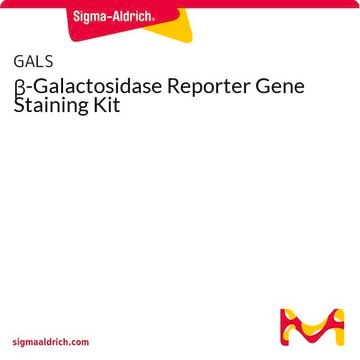推荐产品
生物源
rabbit
共軛
unconjugated
抗體表格
affinity isolated antibody
抗體產品種類
primary antibodies
無性繁殖
polyclonal
形狀
buffered aqueous solution
物種活性
human
技術
immunoprecipitation (IP): 1-2 μg using 293-T cell extracts
microarray: suitable
western blot: 1-2 μg/mL using nuclear extracts of 293-T cells
UniProt登錄號
運輸包裝
dry ice
儲存溫度
−20°C
目標翻譯後修改
unmodified
基因資訊
human ... EHMT2(10919)
mouse ... Ehmt2(110147)
一般說明
G9a (also known as HLA-B-associated transcript 8 (BAT8), G9a/NG36, or NG36) was originally characterized as a molecule encoded by a gene mapped in the class III region of the human major histocompatibility complex locus. G9a as well as EuHTM1 (Eu-HMTase) were found to be the components of the multimeric protein complex E2F-6.
特異性
The antibody recognizes the two isoforms of G9a methyltransferase (~180 kDa and 160 kDa).
免疫原
synthetic peptide corresponding to amino acids 1193-1210 of human G9a, conjugated to KLH via an N-terminal added lysine residue. This sequence differs from the mouse sequence by 3 amino acids.
應用
Anti-G9a Methyltransferase antibody produced in rabbit has been used in:
- immunoblotting
- immunoprecipitation
- immunohistochemical analysis (IHC)
生化/生理作用
In vivo, G9a is essential for early embryonic development and plays a dominant role in H3-K9 methylation of euchromatin. G9a was found to be a critical component of the CtBP and E2F-6 transcriptional repressor complexes. G9a was found to be the enzyme responsible for mono and dimethylation within silent euchromatin.
G9a is a lysine-preferring histone methyltransferase (HMTase) containing a SET domain. It has 10 to 20-fold stronger in vitro HMTase activity towards histone H3-Lys9 (H3-K9) when compared to Suv39H1, another member of the same family of HMTases. It also methylates Lys27 of histone H3. Suv39 h1 methylates only lysine 9. It is capable of mono and dimethylation within silent euchromatin, whereas Suv39h1 trimethylates at pericentric heterochromatin. G9a is an important factor in the early embryonic development and plays a dominant role in H3-K9 methylation of euchromatin in vivo. It also forms a crucial component of the CtBP and E2F-6 transcriptional repressor complexes.
外觀
Solution in 0.01 M phosphate buffered saline, pH 7.4, and 15 mM sodium azide.
免責聲明
Unless otherwise stated in our catalog or other company documentation accompanying the product(s), our products are intended for research use only and are not to be used for any other purpose, which includes but is not limited to, unauthorized commercial uses, in vitro diagnostic uses, ex vivo or in vivo therapeutic uses or any type of consumption or application to humans or animals.
Not finding the right product?
Try our 产品选型工具.
儲存類別代碼
12 - Non Combustible Liquids
水污染物質分類(WGK)
WGK 1
閃點(°F)
Not applicable
閃點(°C)
Not applicable
Methylation of hypoxia-inducible factor (HIF)-1 alpha by G9a/GLP inhibits HIF-1 transcriptional activity and cell migration
Bao L, et al.
Nucleic Acids Research, 46(13), 6576-6591 (2018)
Study of methyl transferase (G9aMT) and methylated histone (H3-K9) expressions in unexplained recurrent spontaneous abortion (URSA) and normal early pregnancy
Fatima N, et al.
Molecular Human Reproduction, 17(11), 693-701 (2011)
G9a histone methyltransferase plays a dominant role in euchromatic histone H3 lysine 9 methylation and is essential for early embryogenesis
Tachibana M, et al.
Genes, 16(14), 1779-1779 (2002)
Inhibition of the H3K9 methyltransferase G9A attenuates oncogenicity and activates the hypoxia signaling pathway
Ho JC, et al.
PLoS ONE, 12(11), e0188051-e0188051 (2017)
The Lysine Methyltransferase G9a in Immune Cell Differentiation and Function
Scheer S, et al.
Frontiers in Immunology, 8 (2017)
我们的科学家团队拥有各种研究领域经验,包括生命科学、材料科学、化学合成、色谱、分析及许多其他领域.
联系技术服务部门








